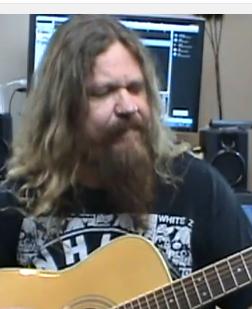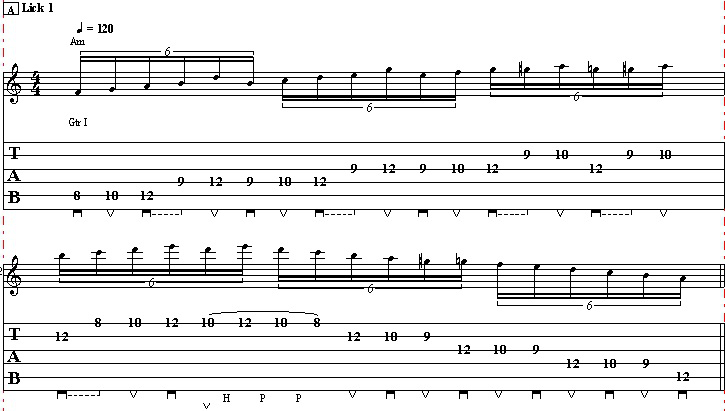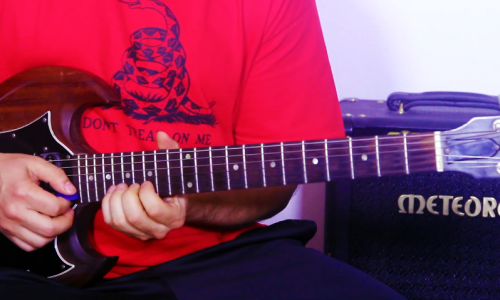Hi everybody. This is Darrin Goodman from guitarcontrol.com
bringing you this video lesson today. Today I want to teach
you a really simple little exercise for fingerpicking that
I came up with. This is going to do kind of a couple of things
here. One, it will help you with chord changing and stuff, you
need a little work on that, but it’s going to work with exercising
your right hand for fingerpicking without just doing boring
exercise. What’s cool about this is it actually sounds like
a song when you get it up to tempo.
The chords that I’m using in this are C, E minor, G, and
then D over F sharp, which is simply an E, but you’re going
to use your thumb to play the 2nd fret of the 6th string.
What’s kind of the cool thing about stuff with finger
picking is that when you play a C chord, for example,
you don’t want to hit that 6th string even though that E
is in that triad. You don’t want that in there because
then your bass note isn’t the root and sometimes it sounds
a little funky. When your fingerpicking, since you’re
arpeggiating it, you’re playing the notes separately,
you can get away with this.
With this picking exercise, basically, it consists of,
you’re just going to start with the C chord and then
you’re going to play starting on the 4th string, your
thumb; 3rd string your 1st finger; 2nd string your 2nd
finger; and the 1st string your 3rd finger, which is
P-I-M-A. You’re going to go P-I-M-A. Now you’re going
to move from playing 4, 3, 2, and 1 to 5, 4, 3, and 2;
same thing, P-I-M-A.
Now you’re going to move it down. So you go 6, 5, 4, 3
and then back up to 5, 4, 3, 2; then back up to 4, 3, 2, 1,
but that’s where you change chords. You’re going to
continuously, throughout the whole thing going 4, 3, 2,
1; 5, 4, 3, 2; 6, 5, 4, 3; 5, 4, 3, 2; and then repeating
it. Each time you start the cycle over, though, you’re
going to change chords. You can do this with any chords.
This progression just sounds nice so that’s what I chose.
But you can do it with anything, even take a song you
don’t even know how to play and screw around with it
with fingerpicking. You might come up with something
really cool. You never know.
Starting with the C were going to go 4, 3, 2, 1; 5,
4, 3, 2; 6, 5, 4, 3; 5, 4, 3, 2. Switch to an E minor
and start over on 4: 4, 3, 2, 1; 5, 4, 3, 2; 6, 5, 4,
3; 5, 4, 3, 2. Switch to a G: 4, 3, 2, 1; 5, 4, 3, 2;
6, 5, 4, 3; 5, 4, 3, 2 . And then to the D over F sharp:
4, 3, 2, 1; 5, 4, 3, 2; 6, 5, 4, 3; 5, 4, 3, 2.
The idea with this when you play it is that you want it
to be continuous you don’t want there to be any
lag in-between chord changes. So this is something
I recommend practicing with a metronome. Just start-off
slow. You can start over and so on and so forth.
Now, when you get where you can do that pretty good,
then just switch up what you do here. Instead of going
P-I-M-A, you could change it to P-M-I-A or P-A-I-M,
whatever, any combination you want. Then you can
really mix it up where you do simultaneous ones.
The favorite one for me is to go P and A together
and then M-I.
I hope you enjoyed that. Be sure to click on the
link in the description for the tabs and like I said,
practice that with the metronome. Start off slow,
gradually build up your speed. Things like this,
only take a few minutes a day. If you dedicated five
or ten minutes to work on this every day in a couple
of weeks, two weeks, 30 days, whatever. It kind of
depends on how consistent you are with it and everybody’s
a little bit different. But you’re going to be able to
fly on it and it sounds really cool and it’s going to
help you with lots of other stuff.
Until next time





